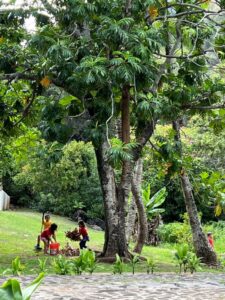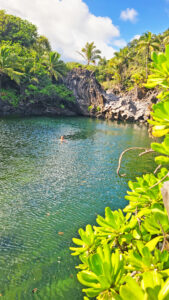Gov. Ige may veto Molokini measure to limit tour boats
Operators back bill; state cites crowds, marine life decline

A commercial tour boat heads for Molokini, the famous crescent-shaped crater located about 3 miles off Maui’s south shore, earlier this year. A measure on permits for commercial use operators, backed by those companies and opposed by the state Department of Land and Natural Resources, passed the state Legislature but is being considered for a veto by Gov. David Ige. DLNR’s Aquatics Division says the bill ties its hands as it tries to manage the conservation district. -- The Maui News / MATTHEW THAYER photo
A measure on tour boat operations for Molokini sailed through the state Legislature only to land on the desk of Gov. David Ige, who is considering sinking the measure.
Molokini, the famous crescent-shaped crater about 3 miles off Maui’s south shore, is the county’s most popular snorkeling and diving spot. It’s also a protected conservation area, managed by the state Department of Land & Natural Resources.
Within the last year, DLNR floated the idea of limiting tour boats to about a dozen at any given time, pointing to studies showing visitor overcrowding and fish displacement. Commercial operators balked at the low number, especially because time in the crater is already restricted by weather, and questioned the DLNR data. They took their concerns to the state Legislature.
Tour companies support House Bill 1133, which would limit the number of commercial use permits for Molokini Marine Life Conservation District to no more than 40 and would limit access at any given time to 50 percent of the current permit holders. It would also require DLNR to immediately initiate rule-making for Molokini.
The bill gained support in various state legislative committees, with no votes of opposition in the last session.
However, Ige took issue with the language that limits access to 50 percent of the current number of permits at any given time. He called it counterproductive to DLNR’s efforts to address overcrowding.
“They set this 50 percent of total number of permits in law . . . so you basically prevent the department from setting a more strict cap on the number of vessels,” said Russell Sparks, a Maui-based aquatic biologist with the DLNR’s Division of Aquatic Resources. “If we don’t have that ability to do that, it will be harder to get voluntary compliance from operators.”
Ige added that the measure is “unnecessary” since DLNR already limits permits to 40.
Denver S. Coon, general counsel for Trilogy Excursions, said commercial boat operators are disappointed with the intent to veto but understand the governor’s inclination to follow his department’s recommendations.
“While we still hope he reverses his decision before the upcoming deadline, our greater hope is that the state works with the commercial tour operators in the future to create smart and effective rules that protect our resources but not at the expense of local residents’ livelihoods,” Coon said Thursday.
The Aquatic Resources Division said it is working with commercial boaters and other stakeholders, such as noncommercial operators and Native Hawaiian cultural practitioners, to help draft new administrative rules for managing Molokini. In March, Sparks led the first public meeting to update the district’s administrative rules, last amended in 1995.
“Basically what we’ve been trying to do with marine operators is set up a voluntary schedule that spreads out their use a little bit,” Sparks said. He added that the department would like to designate moorings for noncommercial users.
The Molokini Marine Life Conservation District was established in 1977 as a highly unique offshore islet. In 1995, rules were put in place to limit commercial permits to prevent uncontrolled growth.
Currently, the district has 24 moorings for use only by permitted commercial operators. Access also is allowed for nonpermitted commercial operators; recreational boaters, snorkelers and divers; fishers who troll in “subzone B” of Molokini; cultural practitioners; and special activity permit holders, according to DLNR rules.
In the March meeting, DLNR said more than 360,000 snorkelers and divers visited Molokini last year, an increase from previous years, and referenced a study in which visitors said they felt crowded. DLNR also presented information linking overcrowding to displacement of a key Molokini reef predator fish, the omilu.
Tour boat operators during the meeting said the survey of visitors was misleading. They also questioned the data on fish displacement amid studies that show Molokini is one of the healthiest reefs in the county.
Sparks said the department plans to move forward with public collaboration on new administrative rules for Molokini. Hearings could be slated for late summer or early fall.
He added that finding the best compromise is important to the department and acknowledged that tour operators provide significant jobs and revenue for the state. Sparks said the department is working to balance commercial, noncommercial, cultural and environmental concerns.
If the measure is vetoed, Coon said, the horizon is unclear for boat operators.
“At first, life will not change due to the time needed by the state to draft new administrative rules governing the Molokini Shoal Marine Life Conservation District,” he said. “However, if the commercial tour operators are unable to provide meaningful input during the rule drafting phase, then there is significant fear that the system, which has worked for over 30 years, will be replaced by one that makes running a business to Molokini both too costly and simply impractical.”
The governor must either sign or veto bills by July 9. If no action is taken on a bill it becomes law without his signature.
* Kehaulani Cerizo can be reached at kcerizo@mauinews.com.
- A commercial tour boat heads for Molokini, the famous crescent-shaped crater located about 3 miles off Maui’s south shore, earlier this year. A measure on permits for commercial use operators, backed by those companies and opposed by the state Department of Land and Natural Resources, passed the state Legislature but is being considered for a veto by Gov. David Ige. DLNR’s Aquatics Division says the bill ties its hands as it tries to manage the conservation district. — The Maui News / MATTHEW THAYER photo






